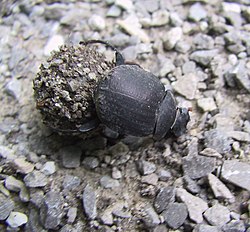| Deltochilum | |
|---|---|
 | |
| Deltochilum gibbosum | |
| Scientific classification | |
| Kingdom: | Animalia |
| Phylum: | Arthropoda |
| Class: | Insecta |
| Order: | Coleoptera |
| Suborder: | Polyphaga |
| Infraorder: | Scarabaeiformia |
| Family: | Scarabaeidae |
| Subfamily: | Scarabaeinae |
| Tribe: | Deltochilini |
| Genus: | Deltochilum Eschscholtz, 1822 |
| Diversity | |
| At least 100 species | |
| Synonyms [1] | |
| |

Deltochilum is a genus of true dung beetles in the family Scarabaeidae native to the Americas. There are more than 100 described species in Deltochilum. [2] [1] [3] [4] [5] Unusually for a dung beetle, a few species in the genus, including D: valgum , are predators that kill and feed on millipedes. [6]
Contents
- D. mexicanum
- showing navigation technique
- in Colombia


